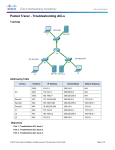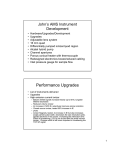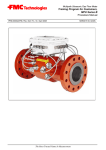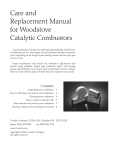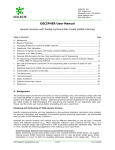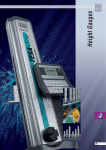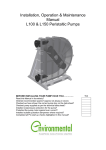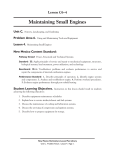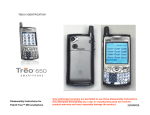Download Bulbs and Circuits
Transcript
Electricity Industrial Technology/Science 9th Grade Electrical Circuit Wiring Prepared By: Joseph Buttitta Overview & Purpose: Students will demonstrate knowledge of electric current flow, recognizing how electric circuits are made and the devices in them are used to transform kinetic energy to thermal energy.. Objectives: Students will… • Build and test a simple switch and light circuit using common house wiring materials, tools and procedures. • Describe and explain what occurs in an electric circuit. Background Information: The class will have previously covered electrical principles (amps, volts, resistance, watts, Ohm’s Law, conductors, insulators, etc.), electrical safety, wiring materials (wires, boxes, switches, outlets, etc.) and basic circuits. The class will have drawn an electrical schematic of a circuit in which a single pole switch controls a keyless light receptacle. Performance Expectations Students who demonstrate understanding can: HS-PS3-5 Develop and use a model of two objects interacting through electric or magnetic fields to illustrate the forces between objects and the changes in energy of the objects due to the interaction. Electricity 1 Lesson 1 Electrical Circuit Wiring Classroom Activities/Procedures & Timeline Pre-lab activity – The students drew a schematic of the switch and light circuit. It’s a good idea to get those out and review them. Lab activity – Obtain the materials and tools necessary for the lab and wire the circuit. Test it. Post-lab activity – Write the report. This exercise will take 3 to 4 class periods (50 minutes each). Assessments: (e.g., lab, quiz, test, oral presentation, survey, rubric, etc.) See the attached lab sheet. • • • • • • • ¾ inch thick plywood about 16 x 20 as a base 2 x 4 metal box 4 x 4 octagonal metal box Single pole switch Keyless light receptacle About 3 feet of 14-2w/g non-metallic sheathed wire. Various handtools, needlenose pliers, wire strippers, cable ripper, screwdrivers, etc. Teacher Resources: Extensions/Homework: As an extension- When students finish with the assignment, ask them to think about what the circuit would look like with a duplex receptacle (that is hot all the time) added. Ask them to draw the schematic and if there’s time, allow them to wire the circuit. References: Wiring Exercises prepared by John E. Smith, Voc. Ag. Service, College of Ag. Univ. of Illinois Wiring Basic and Advanced Projects, Creative Homeowner, Upper Saddle River, NJ Agricultural Mechanics Fundamentals & Applications by Ray Herren and Elmer Cooper, Delmar Publishers Personal Comments/Notes: I found this to be an exercise the students really enjoyed doing. As an additional safety measure I made one or two test plugs and the students put them on when they were ready to test. No one was allowed to test the circuit until I was standing with them watching the process. I used the maintenance staff for our school district as my wiring inspectors and they were very helpful. 2 Equipment/Materials/ Technology Needed: Industrial Technology/Science (e.g., readings, set-up instructions, lecture files, data files, etc.): I used Units 31 and 32 from the Agricultural Mechanics text for the kids to read and discuss. I used the Wiring Basic and Advanced Projects book for wiring project ideas. And I used the VoAg Service manual GT400a to make sure the schematic symbols were correct. Student Resources: (e.g., handouts, worksheets, data, etc.): Attached are the following - Student made schematic sheet. Electrical symbols handout. Accommodations & Safety Concerns: This is a shop activity with electricity so safety rules regarding general shop behavior and use of shop tools need to be covered as well as rules which are specific to electricity. WiringRubric Assignment Grade Grade 9 - 10 9 Objective Build and explain a model of two objects interacting through electric fields to illustrate the forces between objects and the changes in energy due to that interaction. Tasks to complete: • Build an electrical circuit using common house wiring materials, tools and procedures. The circuit to be constructed is a keyless light receptacle controlled by one single pole switch. • Write a summary report. Materials needed: • • • • • • 1 - 2 x 4 metal box 1-4 x 4 octagonal metal box 3 ft. of NM 14-2 w/g wire 1-single pole switch 1-keyless lamp receptacle Associated electrical tools- needle nose pliers, wire stripping tool, Phillips and/or standard tip screwdriver, cable ripper and a test plug provided by the instructor at the appropriate time. Procedure 1 Refer to the schematic drawing you made in an earlier class as a guide to gather materials and construct the circuit. 2 Use common wiring procedures (as prescribed by local and national electrical codes) to assemble the components of your switch and light circuit. 3 Have the circuit checked out by your instructor before attaching the test plug. 4 Test your circuit with the instructor present. 5 Write a summary of your lab work. Summary Report Procedure: Explain, using full sentences, what happens in your circuit as current flows through the devices. Your explanation should include key terms such as electron, kinetic energy, thermal energy, transform, and conductor. Definitions of the purposes of key circuit components such as black, white and bare wires, single pole switch, keyless lamp receptacle and NM 14-2 w/g cable should also be included. Electricity 3 Unit 1 4 Industrial Technology/Science Energy/Electricity Industrial Technology/Science 9th Grade Interpreting a Light Bulb Prepared By: Joseph Buttitta Overview & Purpose: We use light bulbs everywhere and we often don’t know much about them. This lesson allows students to interpret the numbers on a bulb or on the package it comes in. Objectives: Students will… • Read and understand information on a lightbulb. • Design a data chart to record pertinent electrical light bulb information. • Perform math calculations to find amperage and lumens. • Sketch the inside of a light bulb. Background Information: test board. With this electricity unit students have already studied Ohm’s Law wired a simple circuit on a Performance Expectations Students who demonstrate understanding can: HS-PS3-1 Create a computational model to calculate the change in the energy of one component in a system when the change in energy of the other components and energy flows in and out of the system are known. Energy/Electricity 5 Unit 1 Interpreting a Light Bulb Classroom Activities/Procedures & Timeline Students gather their light bulbs and design the data chart they will use. Then they will read and record the information on their chart. Any holes in the chart (lumens and amps) students will fill by making the appropriate math calculations. When the chart is finished students will sketch the inside of a CFL bulb and an incandescent bulb and describe what they think is going on inside. Finally, students answer the four questions on the handout. Assessments: (e.g., lab, quiz, test, oral presentation, survey, rubric, etc.) Teacher made. Students would be assessed on how completely the chart was made and filled out. Also how accurately the students answered the four questions on the handout. • Various light bulbs (LED, CFL, Incandescent, Halogen, etc.). Teacher Resources: (e.g., readings, set-up instructions, lecture files, data files, etc.): Student Resources: (e.g., handouts, worksheets, data, etc.): Extensions/Homework: Attached. This assignment can easily be extended into a research assignment. After sketching and explaining their view of a bulb, they can research bulbs to find out how one really works. References: The definitions can be found in Creative Homeowner Wiring and on Wikipedia. 6 Equipment/Materials/ Technology Needed: Industrial Technology/Science Accommodations & Safety Concerns: Bulbs break if you drop them! Activity Sheet Grade 9 Interpreting a Light Bulb Objective: • • • • Read and understand information on a light bulb. Design a data chart to record pertinent electrical light bulb information. Perform math calculations to find amperage and lumens Sketch a light bulb Materials: Various light bulbs (incandescent, LED, halogen, CFL) Vocabulary: Volt - The force that causes current to flow in an electrical circuit. Watt - The unit of measurement for the amount of energy needed to power an electrical device. Ampere - The unit for the measure of rate, or strength of electrical flow. Lumen - The measure of the total amount of visible light emitted by a source. LED - Light Emitting Diode CFL - Compact Fluorescent Light bulb. Incandescent bulb - An electric light bulb that produces light with a wire filament. Halogen bulb - A form of incandescent light bulb. Formulas: • • • • • Amps = watts/volts An incandescent bulb emits 16 lumens/watt. A CFL bulb emits 50-70 lumens/watt An LED bulb emits 100 lumens/watt A halogen bulb emits 15 lumens/watt Energy/Electricity 7 Unit 1 Interpreting a Light Bulb Procedure: 1 Gather your light bulbs (LED, CFL, Incandescent, Halogen). 2 Design a data chart and record service life, volt and watt information. 3 Calculate amperage for each bulb and record the information. 4 Calculate lumens for each bulb and record the information. Questions: 1 Which bulb gives off the most amount of visible light? How do you know? 2 How many years will the LED bulb you tested last? 3 The average general lighting circuit in your home will safely carry 15 amps of current. How many 60W incandescent bulbs can be put into a circuit before the circuit breaker trips? 4 How many CFL bulbs can be put into a circuit before the circuit breaker trips? Sketching: Sketch the inside of an incandescent bulb as you imagine it and describe how you think it works. Do the same thing with a CFL bulb. Definitions and formulas came from either Creative Homeowner Wiring or Wikipedia. 8 Industrial Technology/Science Energy/Electricity Industrial Technology/Science 9th Grade How a Light Bulb Works Prepared By: Joseph Buttitta Overview & Purpose: Generally, when a light bulb goes out in our homes we replace it with a new one with little thought as to how it works. This assignment will give students the opportunity to learn about light bulbs. Specifically, how they are made and how they produce light. Objectives: Students will… • Be able to explain how a light bulb works • Produce a drawing of a light bulb and label the essential components Background Information: Students may be familiar with Ohm’s Law and associated electrical definitions. Students will be familiar with the names of various types of light bulbs (incandescent, LED, CFL, Halogen, fluorescent) used in our homes today based previous class discussion. Performance Expectations Students who demonstrate understanding can: HS-PS3-5 Develop and use a model of two objects interacting through electric or magnetic fields to illustrate the forces between objects and the changes in energy of the object due to the interaction. Energy/Electricity 9 Unit 1 How a Light Bulb Works Classroom Activities/Procedures & Timeline • Class discussion about various lighting sources, terms and definitions, and the preliminary sketching activity. 30 minutes • Research a particular light source (bulb), write a report and make another, accurate, drawing of a bulb. 60 minutes. Assessments: (e.g., lab, quiz, test, oral presentation, survey, rubric, etc.) • • • Access to a computer for research and report writing. Drawing materials for the bulb sketches. Various types of light bulbs for examination. Teacher Resources: Extensions/Homework: Look up the terms luminous efficacy and lighting efficiency, then explain the differences and similarities between the two terms and why consumers may be confused about what the terms mean. (e.g., readings, set-up instructions, lecture files, data files, etc.): Student Resources: References: (e.g., handouts, worksheets, data, etc.): The definitions used on this assignment come from either Wikipedia or the book Creative Homeowner, Wiring. 10 Equipment/Materials/ Technology Needed: Industrial Technology/Science How a Light Bulb Works procedure sheet Activity Sheet Grade 9 HOW A LIGHT BULB WORKS Objective: • • Explain how a specific light bulb works . Draw a light bulb and label the components. Vocabulary: Volt - The force that causes current to flow in an electrical circuit. Watt - The unit of measurement for the amount of energy needed to power an electrical device. Ampere - The unit for the measure of rate, or strength of electrical flow. Lumen - The measure of the total amount of visible light emitted by a source. LED - Light Emitting Diode CFL - Compact Fluorescent Light bulb Incandescent bulb - An electric bulb that produces light with a wire filament. Halogen bulb - A form of incandescent light bulb. Luminous efficacy - The measure of how well a light source produces visible light. Procedure: 1 Sketch the outside of your bulb as you see it. 2 Sketch the inside of your bulb as you think it should be and write how you believe it works. 3 Conduct research on your bulb. Make notes and sketches as necessary. 4 Make an accurate representation (drawing) of your bulb and write how it works. 5 Compare your original drawing with the drawing done after your research and note changes. Questions: 1 Compare the drawings of the bulbs. Did the original drawing look different than the drawing done after the research? Explain the differences in the drawings and in your understanding of how the bulb works. 2 Based on your research please comment on how efficient your bulb is to use in terms of how much light it gives off in relation to the amount of energy needed to produce light. Energy/Electricity 11 Unit 1 12 Industrial Technology/Science Energy/Electricity Industrial Technology/Science 9th Grade Which Bulb is Best? Prepared By: Joseph Buttitta Overview & Purpose: In many bulbs we know that much of the energy is thermal rather than radiant. The purpose of this lab is to help students learn how much heat common bulbs give off. Objectives: Students will… • Design a method to test various types of light bulbs. • Design a graph and data table to record pertinent data. • Take the temperature of various light bulbs. • Interpret data to determine the best solution to the problem. Background Information: Students have already been introduced to Ohm’s Law and built a simple circuit. Performance Expectations Students who demonstrate understanding can: HS-PS3-1 Create a computational model to calculate the change in the energy of one component in a system when the change in energy of the other components and energy flows in and out of the system are known. Energy/Electricity 13 Unit 1 Which Bulb is Best Classroom Activities/Procedures & Timeline • • • • • Gather light bulbs and write a hypothesis. • Use the recorded data to determine which bulb is appropriate for the application. Design a method to test your light bulbs. Design a graph on which to record data points. Create a data chart to help visualize the data. Use the thermometer to measure the heat given off from each of the light bulbs and record. Assessments: (e.g., lab, quiz, test, oral presentation, survey, rubric, etc.) Teacher-made depending upon the number of bulbs tested and other questions asked. Equipment/Materials/ Technology Needed: • • • Various light bulbs (incandescent, LED, CFL, etc.) Lamp receptacle and a source of power. Digital thermometer Teacher Resources: (e.g., readings, set-up instructions, lecture files, data files, etc.): Student Resources (e.g.,handouts, worksheets, data, etc.): Attached Accommodations & Safety Concerns: Bulbs may get hot when they are on, and they break when they are dropped. 14 Industrial Technology/Science Activity Sheet Grade 9 Which Bulb is Best? Design Problem The local auto parts store has a new service counter. The owner has hired you to design and install the overhead lighting. There needs to be adequate light but not so much heat that customers and employees can feel it. Your task is to determine which type of bulb is best for the application. Objectives • • • • Design a method to test various types of light bulbs. Design a graph and data table to record your data. Take the temperature of your bulbs. Interpret the data to determine which bulb is best to use. Materials • • • Various light bulbs (LED, CFL, incandescent, halogen, etc.) Lamp receptacle and a source of power Digital thermometer Procedure 1 Gather your light bulbs and write a hypothesis. 2 Design a method to test (measure the heat) your light bulbs. 3 Design a graph on which to record data points. Consider your independent and dependent variables. 4 Create a data chart to help visualize the data. Consider your constants. 5 Use the thermometer to test your bulbs. Fill out your graph and fill in the data chart. 6 From your recorded data determine which style of bulb is appropriate for your counter application. 7 Answer the following questions. Energy/Electricity 15 Unit 1 Which Bulb is Best Questions 1 What is your dependent variable? 2 What is your independent variable? 3 List three constants on your data chart. 4 Did your hypothesis prove correct? Explain why or why not. 5 Which bulb will you use for the counter problem? 6 How can you make the testing procedure more accurate? 7 What will happen to the temperature of the bulbs if you left them on for an indefinite period of time? 8 Based on your research please explain the temperature differences from bulb to bulb. 16 Industrial Technology/Science
















